
The horned lark or shore lark is a species of lark in the family Alaudidae found across the northern hemisphere. It is known as "horned lark" in North America and "shore lark" in Europe.

The alpine newt is a species of newt native to continental Europe and introduced to Great Britain and New Zealand. Adults measure 7–12 cm (2.8–4.7 in) and are usually dark grey to blue on the back and sides, with an orange belly and throat. Males are more conspicuously coloured than the drab females, especially during breeding season.
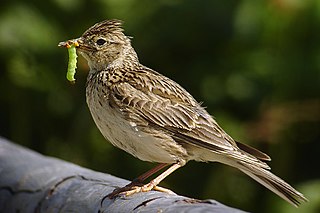
Alauda is a genus of larks found across much of Europe, Asia and in the mountains of north Africa, and one of the species endemic to the islet of Raso in the Cape Verde Islands. Further, at least two additional species are known from the fossil record. The current genus name is from Latin alauda, "lark". Pliny the Elder thought the word was originally of Celtic origin.
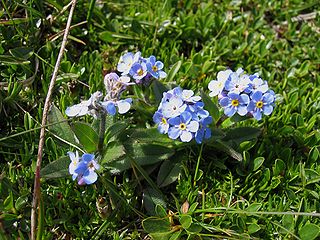
Myosotis alpestris or alpine forget-me-not is a herbaceous perennial plant in the flowering plant family Boraginaceae. The alpine forget-me-not is the county flower of Westmorland in the United Kingdom.

Agoseris is a small genus of annual or perennial herbs in the family Asteraceae described as a genus in 1817.
Amara alpestris is a species of beetle of the genus Amara in the family Carabidae that is native to Asia.

Puya alpestris is a species of bromeliad endemic to the Chilean Andes. It is native to dry hills, rock outcrops in central and southern Chile at elevations of 0 to 2200 meters. It is one of the most southerly occurring species within the family. It is one of the few Puya species that are grown in some parks and gardens as an ornamental plant. It is more commonly known as the Sapphire Tower.

Vertigo alpestris is a species of minute, air-breathing land snail, terrestrial pulmonate gastropod molluscs or micromollusks in the family Vertiginidae, the whorl snails.
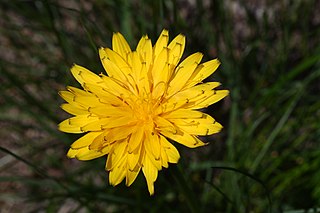
Nothocalais alpestris is a species of flowering plant in the family Asteraceae known by the common name alpine lake false dandelion. It is native to the Cascade Range, Sierra Nevada and other mountains from northern Washington to central California, where it grows in subalpine forests and meadows, most commonly at 1,200–2,700 m (4,000–9,000 ft) elevation.

Goodenia hederacea, commonly known as forest goodenia or ivy goodenia, is a species of flowering plant that is endemic to eastern Australia. It is a prostrate to ascending, perennial herb with linear to elliptic or round leaves, and racemes of yellow flowers.

Ichthyosaura is a genus of newts in the family Salamandridae, found in Europe. The only extant species is the alpine newt, although two fossil species are also known.
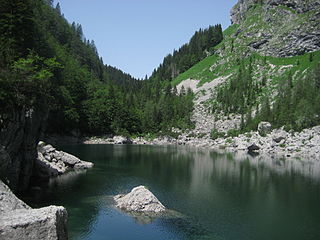
Black Lake is the lowest-lying lake in the Triglav Lakes Valley, part of the Julian Alps in Slovenia. It is named for its location in a basin in the middle of the forest, which stretches right to the edge of the Komarča rock face. Because of its relatively low elevation, it is the warmest of the Triglav Lakes. At the surface, its temperature in summer is 9 °C (48 °F), whereas in winter it is 3 °C (37 °F). It is 150 m (490 ft) long, 80 m (260 ft) wide, and up to 6 m (20 ft) deep. The Alpine Newt, endemic to the Alps, lives in it.
Setina alpestris is a moth in the family Erebidae. It was described by Philipp Christoph Zeller in 1865. It is found in the Alps of Switzerland and Italy.
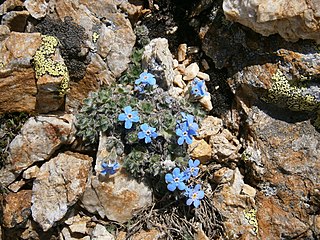
Alpine forget-me-not is a common name for several plants in the Boraginaceae (forget-me-not) family and may refer to:
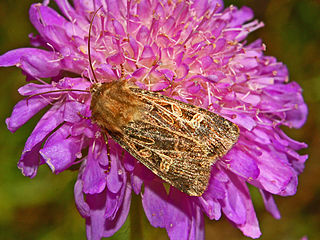
Chersotis alpestris is a moth of the family Noctuidae.
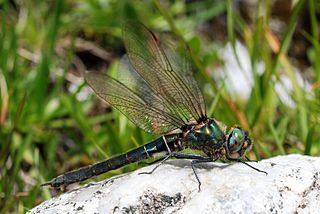
Somatochlora alpestris, or the alpine emerald, is a species of dragonfly from the family Corduliidae. It is found in European highlands, southern Scandinavia, and east to southern Siberia in Asia.

Crassula alpestris, also known as the sand-coated crassula, is a species of flowering plant in the genus Crassula endemic to the Cape Provinces of South Africa. Crassula alpestris subsp. massonii is a variety of the species, also found in South Africa.

Lactuca alpestris is a species of plant native to Crete in the Ida mountains and is a relative of lettuce.
Myersophis is a genus of snake in the family Cyclocoridae. It contains only one species, Myersophis alpestris or Myers's mountain snake, which is endemic to the Philippines.
Gemmaspora is a single-species fungal genus of uncertain familial placement in the order Verrucariales. It contains Gemmaspora lecanorae, a lichenicolous (lichen-dwelling) fungus that parasitises the lichen genus Aspicilia. The genus was proposed in 2007 by David Hawksworth and Gökhan Halici to contain the fungus formerly known as Adelococcus lecanorae. This species, originally described by Roger-Guy Werner in 1963, occurs in Syria and Turkey.














